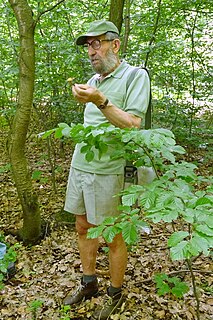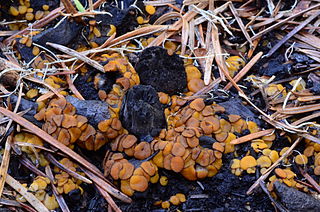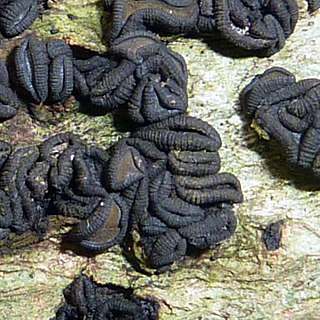
Mycology is the branch of biology concerned with the study of fungi, including their genetic and biochemical properties, their taxonomy and their use to humans as a source for tinder, traditional medicine, food, and entheogens, as well as their dangers, such as toxicity or infection.

The Russulales are an order of the Agaricomycetes,. According to the Dictionary of the Fungi, the order consists of 12 families, 80 genera, and 1767 species. According to Species Fungorum, the order contains 13 families, 117 genera, and 3,060 species.

The International Code of Nomenclature for algae, fungi, and plants (ICN) is the set of rules and recommendations dealing with the formal botanical names that are given to plants, fungi and a few other groups of organisms, all those "traditionally treated as algae, fungi, or plants". It was formerly called the International Code of Botanical Nomenclature (ICBN); the name was changed at the International Botanical Congress in Melbourne in July 2011 as part of the Melbourne Code which replaced the Vienna Code of 2005.
Index Fungorum is an international project to index all formal names in the fungus kingdom. As of 2015 the project is based at the Royal Botanic Gardens, Kew, one of three partners along with Landcare Research and the Institute of Microbiology, Chinese Academy of Sciences.

Lewis David de Schweinitz was a German-American botanist and mycologist. He is considered by some the "Father of North American Mycology", but also made significant contributions to botany.

The Marasmiaceae are a family of basidiomycete fungi which have white spores. They mostly have tough stems and the capability of shrivelling up during a dry period and later recovering. The widely consumed edible fungus Lentinula edodes, the shiitake mushroom, is a member of this family. According to a 2008 estimate, the family contains 54 genera and 1590 species.
MycoBank is an online database, documenting new mycological names and combinations, eventually combined with descriptions and illustrations. It is run by the Centraalbureau voor Schimmelcultures fungal biodiversity center in Utrecht.
Elsinoe rosarum, Anthracnose, is a fungal plant pathogen. It is a condition found on roses, causing leaves to have irregular dark margins and spots. The disease usually appears during wet weather.

August Johann Georg Karl Batsch was a German naturalist. He was a recognised authority on mushrooms, and also described new species of ferns, bryophytes, and seed plants.

The Pertusariales are an order of fungi in the class Lecanoromycetes. According to Species Fungorum it contains the following families: Agyriaceae, Coccotremataceae, Icmadophilaceae, Megasporaceae, Microcaliciaceae, Miltideaceae, Ochrolechiaceae, Pertusariaceae, Varicellariaceae. Many of these fungi form lichens.

Cylindrobasidium is a genus of corticioid fungi in the family Physalacriaceae. circumscribed by Swiss mycologist Walter Jülich in 1974, As of June 2015, Index Fungorum lists eight species in the genus.

Henningsomyces is a genus of fungi in the family Marasmiaceae.
Lenzitopsis is a genus of fungi in the family Thelephoraceae. This genus contains two species, the type Lenzitopsis oxycedri and L. daii, described as new to science in 2012.

Guepinia is a genus of fungus in the Auriculariales order. It is a monotypic genus, containing the single species Guepinia helvelloides, commonly known as the apricot jelly. The fungus produces salmon-pink, ear-shaped, gelatinous fruit bodies that grow solitarily or in small tufted groups on soil, usually associated with buried rotting wood. The fruit bodies are 4–10 cm (1.6–3.9 in) tall and up to 17 cm (6.7 in) wide; the stalks are not well-differentiated from the cap. The fungus, although rubbery, is edible, and may be eaten raw with salads, pickled, or candied. It has a white spore deposit, and the oblong to ellipsoid spores measure 9–11 by 5–6 micrometers. The fungus is widely distributed in the Northern Hemisphere, and has also been collected from South America.

František Kotlaba was a Czech botanist and mycologist.

Anthracobia melaloma is a species of apothecial fungus belonging to the family Pyronemataceae. It produces orangish cup-or disc-like fruit bodies that have small brown hairs around the edge. Fruit bodies occur in burn sites.

Saproamanita nauseosa is a species of agaric fungus in the family Amanitaceae. First described by English mycologist Elsie Maud Wakefield in 1918 as a species of Lepiota, it was named for its nauseating odor. The type specimen was found growing on soil in the Nepenthes greenhouse at Kew Gardens. Derek Reid transferred the species to Amanita in 1966, and then in 2016 the separate genus Saproamanita was created by Redhead et al. for saprophytic Amanitas and it was transferred to this new genus.

Rhytidhysteron is a genus of fungi in the family Patellariaceae.

Lepiota erminea, commonly known as the dune dapperling, is a species of agaric fungus in the family Agaricaceae. It is found in Europe and North America.















